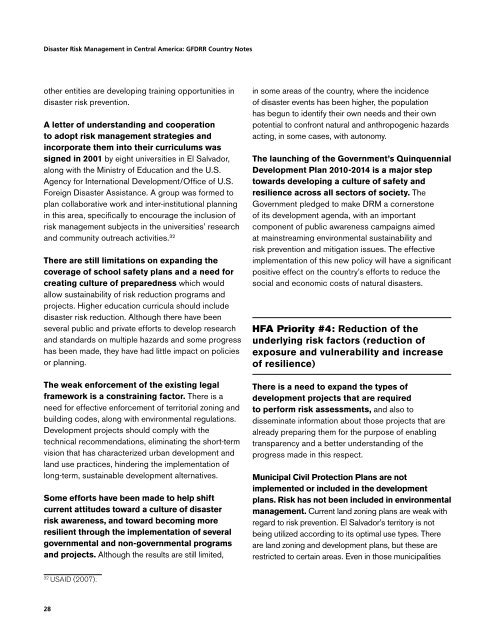Disaster Risk Management in Central America: GFDRR Country Notes
Disaster Risk Management in Central America: GFDRR Country Notes
Disaster Risk Management in Central America: GFDRR Country Notes
Create successful ePaper yourself
Turn your PDF publications into a flip-book with our unique Google optimized e-Paper software.
<strong>Disaster</strong> <strong>Risk</strong> <strong>Management</strong> <strong>in</strong> <strong>Central</strong> <strong>America</strong>: <strong>GFDRR</strong> <strong>Country</strong> <strong>Notes</strong><br />
other entities are develop<strong>in</strong>g tra<strong>in</strong><strong>in</strong>g opportunities <strong>in</strong><br />
disaster risk prevention.<br />
A letter of understand<strong>in</strong>g and cooperation<br />
to adopt risk management strategies and<br />
<strong>in</strong>corporate them <strong>in</strong>to their curriculums was<br />
signed <strong>in</strong> 2001 by eight universities <strong>in</strong> El Salvador,<br />
along with the M<strong>in</strong>istry of Education and the U.S.<br />
Agency for International Development/Office of U.S.<br />
Foreign <strong>Disaster</strong> Assistance. A group was formed to<br />
plan collaborative work and <strong>in</strong>ter-<strong>in</strong>stitutional plann<strong>in</strong>g<br />
<strong>in</strong> this area, specifically to encourage the <strong>in</strong>clusion of<br />
risk management subjects <strong>in</strong> the universities’ research<br />
and community outreach activities. 32<br />
There are still limitations on expand<strong>in</strong>g the<br />
coverage of school safety plans and a need for<br />
creat<strong>in</strong>g culture of preparedness which would<br />
allow susta<strong>in</strong>ability of risk reduction programs and<br />
projects. Higher education curricula should <strong>in</strong>clude<br />
disaster risk reduction. Although there have been<br />
several public and private efforts to develop research<br />
and standards on multiple hazards and some progress<br />
has been made, they have had little impact on policies<br />
or plann<strong>in</strong>g.<br />
The weak enforcement of the exist<strong>in</strong>g legal<br />
framework is a constra<strong>in</strong><strong>in</strong>g factor. There is a<br />
need for effective enforcement of territorial zon<strong>in</strong>g and<br />
build<strong>in</strong>g codes, along with environmental regulations.<br />
Development projects should comply with the<br />
technical recommendations, elim<strong>in</strong>at<strong>in</strong>g the short-term<br />
vision that has characterized urban development and<br />
land use practices, h<strong>in</strong>der<strong>in</strong>g the implementation of<br />
long-term, susta<strong>in</strong>able development alternatives.<br />
Some efforts have been made to help shift<br />
current attitudes toward a culture of disaster<br />
risk awareness, and toward becom<strong>in</strong>g more<br />
resilient through the implementation of several<br />
governmental and non-governmental programs<br />
and projects. Although the results are still limited,<br />
<strong>in</strong> some areas of the country, where the <strong>in</strong>cidence<br />
of disaster events has been higher, the population<br />
has begun to identify their own needs and their own<br />
potential to confront natural and anthropogenic hazards<br />
act<strong>in</strong>g, <strong>in</strong> some cases, with autonomy.<br />
The launch<strong>in</strong>g of the Government’s Qu<strong>in</strong>quennial<br />
Development Plan 2010-2014 is a major step<br />
towards develop<strong>in</strong>g a culture of safety and<br />
resilience across all sectors of society. The<br />
Government pledged to make DRM a cornerstone<br />
of its development agenda, with an important<br />
component of public awareness campaigns aimed<br />
at ma<strong>in</strong>stream<strong>in</strong>g environmental susta<strong>in</strong>ability and<br />
risk prevention and mitigation issues. The effective<br />
implementation of this new policy will have a significant<br />
positive effect on the country’s efforts to reduce the<br />
social and economic costs of natural disasters.<br />
HFA Priority #4: Reduction of the<br />
underly<strong>in</strong>g risk factors (reduction of<br />
exposure and vulnerability and <strong>in</strong>crease<br />
of resilience)<br />
There is a need to expand the types of<br />
development projects that are required<br />
to perform risk assessments, and also to<br />
dissem<strong>in</strong>ate <strong>in</strong>formation about those projects that are<br />
already prepar<strong>in</strong>g them for the purpose of enabl<strong>in</strong>g<br />
transparency and a better understand<strong>in</strong>g of the<br />
progress made <strong>in</strong> this respect.<br />
Municipal Civil Protection Plans are not<br />
implemented or <strong>in</strong>cluded <strong>in</strong> the development<br />
plans. <strong>Risk</strong> has not been <strong>in</strong>cluded <strong>in</strong> environmental<br />
management. Current land zon<strong>in</strong>g plans are weak with<br />
regard to risk prevention. El Salvador’s territory is not<br />
be<strong>in</strong>g utilized accord<strong>in</strong>g to its optimal use types. There<br />
are land zon<strong>in</strong>g and development plans, but these are<br />
restricted to certa<strong>in</strong> areas. Even <strong>in</strong> those municipalities<br />
32<br />
USAID (2007).<br />
28
















